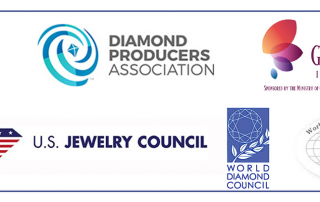CIBJO President visits Bahrain as guest of DANAT, Arabian Gulf country’s official pearl and gemstone institute
Kenneth Scarratt (centre), CEO of DANAT and President of the CIBJO Pearl Commission, giving CIBJO President Gaetano Cavalieri a tour of the Bahrain Institute for Pearls & Gemstones’ new gem and pearl testing facility in Manama.
April 10, 2018
CIBJO President Gaetano Cavalieri has concluded a week-long visit to the Kingdom of Bahrain, as the guest of DANAT, the Bahrain Institute for Pearls & Gemstones, during which he met with the leadership of the country’s fast-developing gemstone and jewellery centre, and discussed the possibility of its hosting the CIBJO Congress in 2019.
Located on an archipelago on the northern flank of the Arabian Peninsula, the energy-rich Kingdom of Bahrain is home to a pearling industry that traces its history back 4,000 years. DANAT, the Bahrain Institute for Pearls and Gemstones, was formerly was established in 2017, as a wholly-owned subsidiary of the Bahrain Mumtalakat Holding Company, the Kingdom’s sovereign wealth fund. Upgrading a 27-year pearl and gem-testing laboratory that, when it was formed in 1990, was the first such facility in the Middle East, under its new structure and with a state of the art laboratory it aims to become an internationally-recognised institute for third party verification services and scientific research into pearls and gemstones.
Although it just recently announced the discovery of massive shale oil reserves off its western coast, Bahrain was the first of the Gulf states to make the transition from a predominantly energy-based economy into a one that is today anchored by banking, trade and tourism. Mumtalakat was created by a royal decree in 2006, with the objective of pursuing long-term value-enhancing opportunities for the country’s state-owned, non-oil and gas-related assets. It established DANAT from the older Pearl & Gem Testing Laboratory to support the country’s distinguished pearling history and heritage, as well as to tap into the rapid growth of the jewellery industry across the world, though the issuance of verification and authentication reports, continuous scientific research and analysis of pearls and gemstones, and the provision of ongoing training programmes in the field of gemmology.
To manage the process, DANAT appointed Kenneth Scarratt, a world renowned gemmologist as its CEO. Mr. Scarratt also serves as President of CIBJO’s Pearl Commission.
“One of our guiding principles in CIBJO is our conviction that the jewellery and gemstone business, if responsibly and professionally managed, has the capacity to generate economic opportunity, growing existing markets and creating new ones where they never existed,” said Dr. Cavalieri. “For that to happen, however, the proper infrastructure and a wealth of knowledge is required. This is what we are seeing in Bahrain. Its impact on the markets in the Gulf region, the Middle East and far beyond is likely to be tremendous.”
During his meetings in Bahrain, DANAT Chairman Yaser Alsharifi and Mr. Scarratt proposed that Bahrain’s capital of Manama host the CIBJO Congress in 2019. “We were honoured to receive the invitation, which will be brought for discussion before the CIBJO Board of Directors,” Dr. Cavalieri said. “It is an event that brings together the leadership of the international jewellery and gemstone industry from around the world, and it certainly be an excellent showcase for what is being built and achieved today in Bahrain.”
CIBJO President promotes international acceptance of CIBJO Blue Books as the common frame of reference for jewellery standards and nomenclature
CIBJO President Gaetano Cavalieri addressing the jewellery industry standards seminar at the Hong Kong International Jewellery Show on March 3, where he urged acceptance of the CIBJO Blue Book standards and nomenclature as a ‘common language’ for the international jewellery and gemstone trade.
March 6, 2018
Speaking at an industry seminar in Hong Kong, CIBJO President Gaetano Cavalieri has urged both government authorities and jewellery and gemstone associations to incorporate the standards and nomenclature contained in the CIBJO Blue Books into their respective national guidelines, as a measure designed to facilitate more transparent and efficient international trade.
The CIBJO Blue Books are definitive sets of grading standards and nomenclature for diamonds, coloured gemstones, pearls, coral, precious metals, and gemmological laboratories. They are compiled and are consistently updated by relevant CIBJO Commissions, whose members include representatives of trade organisations and laboratories active in the diamond, coloured gemstone, pearl, precious metals and jewellery industries.
“It is essential because we work in an industry where there is almost no single item produced that does not includes elements that were either mined, processed and manufactured in multiple countries,” Dr. Cavalieri said, during a seminar on March 3 at the Hong Kong International Jewellery Show organised by the Gemmological Association of Hong Kong and the Innovation and Technology Commission of the Hong Kong SAR Government. “What this means is that gemstones, jewellery components and complete jewellery items are constantly crossing borders, and are being handled and valued by different people in each of the countries they pass through. It is absolutely essential that members of our industry in one country can communicate accurately with their colleagues in other countries, using a common professional language.”
“The application of the Blue Books is voluntary, but increasingly they are becoming recognized as common standards,” Dr. Cavalieri noted. He listed milestones in this process:
- In 2004 a German district court used terminology and definitions contained in CIBJO’s Diamond Book to decide a case involving misrepresentation of synthetic diamonds, the first time the Blue Books were cited in European case law.
- In 2013 CIBJO’s Blue Book standards for pearls and precious metals were accepted as national standards in the Philippines.
- In 2015, the International Standards Organisation approved ISO International Standard 18323, which for specifies a set of permitted descriptors for the diamond industry. The new standard mirrored almost exactly the existing definitions outlined in CIBJO’s Diamond Blue Book.
- In 2017, CIBJO, the World Federation of Diamond Bourses and the International Diamond Manufacturers Association reached agreement, by which the nomenclature used by the International Diamond Council (IDC) will be harmonised with that of CIBJO’s Diamond Blue Book. As a result, the CIBJO Diamond Book now functions as the single official reference book for nomenclature in the entire diamond and jewellery industry.
- In January 2018 an MOU was signed with the Russian government aimed at harmonizing the system used in that country for the classification of polished diamonds with the CIBJO Blue Book.
“The process of developing the Blue Books is remarkable, and is a testament to the dedication, professionalism, expertise and voluntary spirit of members of our community,” Dr. Cavalieri said, calling on member of the industry in Hong Kong and China, to work with CIBJO to expand the relevance to more countries and product categories, including Fei Cui, which involves jade and jadeite materials that are popular in the region.
“The CIBJO Commissions that compile and update the CIBJO Blue Books do not work in isolation. They are made up by industry members, like yourself, who are ready to contribute,” he stated. “Members of the Hong Kong and Chinese industries have long played key roles in our commission, and this practice needs to continue.”


-

 Diamond and jewellery organisations present ‘Diamond Terminology Guideline,’ setting universal standard for communicating about diamonds and synthetic diamonds Gallery
Diamond and jewellery organisations present ‘Diamond Terminology Guideline,’ setting universal standard for communicating about diamonds and synthetic diamonds GalleryDiamond and jewellery organisations present ‘Diamond Terminology Guideline,’ setting universal standard for communicating about diamonds and synthetic diamonds
Diamond and jewellery organisations present ‘Diamond Terminology Guideline,’ setting universal standard for communicating about diamonds and synthetic diamonds
January 30, 2018
Nine of the leading diamond and jewellery industry organisations (AWDC, CIBJO, DPA, GJEPC, IDI, IDMA, USJC, WDC and WFDB) have released a jointly developed Diamond Terminology Guideline to encourage full, fair and effective use of a clear and accessible terminology for diamonds and synthetics diamonds by all sector bodies, organisations, traders and retailers.
While not legally binding, the Diamond Terminology Guideline is designed to serve as the reference document when referring to or describing diamonds, synthetic diamonds and imitations of diamonds. It is built on two internationally accepted standards: the ISO 18323 Standard (“Jewellery – Consumer confidence in the diamond industry”) and the CIBJO Diamond Blue Book.
“Protecting consumer confidence is of paramount importance to the long-term success of our industry,” said CIBJO President Gaetano Cavalieri. “The Diamond Terminology Guideline is an important tool in achieving this, by helping standardise the terminology used to clearly distinguish between diamonds and synthetic diamonds, in all communications, among ourselves and with our customers.”
“The Diamond Terminology Guideline is an important complement to the CIBJO Blue Book, with which it is fully consistent. It provides for easy and simple reference and will be distributed broadly within the industry. The accessible language, the succinct format and the broad support from leading industry organisations is intended to stimulate widespread implementation within trade and at the retail level,” Dr Cavalieri said.
To download the Diamond Terminology Guideline in PDF format, PLEASE CLICK HERE.



